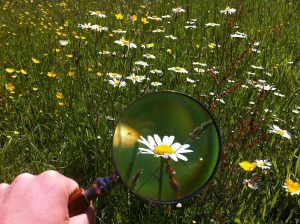1 Knowledge of the Nature of Science (NOS)
The Nature of Science (NOS) can be broadly defined as the way people develop, test, and refine scientific knowledge. According to the Next Generation Science Standards, basic NOS understandings include:
- Scientific investigations use a variety of methods.
- Scientific knowledge is based on empirical evidence.
- Scientific knowledge is open to revision in light of new evidence.
- Scientific models, laws, mechanisms, and theories explain natural phenomena.
- Science is a human endeavor.
(NGSS Lead States, 2013)
Scientific investigations use a variety of methods
Even the youngest students should understand that every scientific inquiry begins with a question. Scientists can use a variety of investigations, including controlled experiments, surveys and observations to answer their questions. They select their method of investigation based on the question they are trying to answer.
When teaching, you should use the general term “investigation” when referring to classroom science activities. There are three main types of investigations that you can do with your students: descriptive investigations, comparative investigations, and experimental investigations (e.g., controlled experiments, fair tests). Table 1 describes each of the three types of investigations. Controlled experiments are typically more appropriate for upper elementary students or middle school students who can think logically about cause-effect relationships between variables.

Table 1. Three Types of Science Investigations
| Investigation type | Definition | Example |
| Descriptive | An investigation in which students make and record observations of objects or natural events (phenomena). | Students wonder how many different kinds of birds visit the bird feeder outside their classroom window. They observe and record the types of birds that visit the bird feeder over a week in October. |
| Comparative | An investigation in which students make and record observations to compare two or more objects or phenomena | Students wonder if different types of birds visit the bird feeder in the fall and winter. They predict that they will see some different birds based on their research. They record the types of birds that visit the bird feeder over a week in both October and December. |
| Experimental | An investigation in which students test a hypothesis and control variables so that they can determine the cause-effect relationship between the independent and dependent variables | Students wonder if different seed mixes attract different types of birds. They predict that a seed mix with mostly sunflower seeds will attract more cardinals based on their research. First, they record the types of birds that visit the feeder containing the regular seed mix over a week. The following week, they change the seed mix to an 80% sunflower mix and again record the types of birds that visit the feeder. In investigation, students are exploring the possible cause and effect relationship between the seed mix (independent variable-cause) and the types of birds (dependent variable-effect). |
Scientific knowledge is based on empirical evidence
Scientists can only study what they can observe. Therefore, all scientific knowledge is based on scientists’ careful observations and measurements of natural events. These observations and measurements are called data or evidence. When scientists analyze and interpret data, they will try to identify trends and pattern. This process eventually leads to the development of evidence-based explanations of natural events.

Scientific knowledge is open to revision in light of new evidence
Scientific knowledge is continuously growing with new discoveries about the natural world. Sometimes the evidence supports what scientists already think about how and why things work. However, sometimes the evidence refutes well-accepted explanations and scientists have to change what they think to align with the evidence. The development of Cell Theory is an example of how scientific knowledge can change over time. Watch the video below to learn how scientists came to accept the idea that all living things are composed of cells.
“The Wacky History of Cell Theory” by Lauren Royal-Woods is licensed under CC BY NC ND 4.0.
Scientific models, laws, mechanisms, and theories explain natural phenomena
Scientific models include the various representations that scientists use to develop and share their ideas about phenomena, particularly objects or events that are challenging to observe in real time (i.e., they are too small, too big, too fast, or too slow). Scientists use three main types of models, including physical, conceptual and mathematical/computer-based models. They often use mathematical or computer-based models to make predictions about phenomena (e.g, hurricanes). Like scientists, students can use models to clarify and communicate their own understanding of science concepts. The table below describes the three kinds of models and provides examples of ways students could use each.
Table 2. Three Types of Scientific Models
| Model type | Description | Examples |
| Physical | Constructed of materials that you can see and touch | Exploring the moon phases using a foam ball and a lamp, building a replica of a watershed using household materials |
| Conceptual | Based on mental models, often shown in drawings , diagrams or illustrations | Drawing the arrangement of water molecules in ice, drawing the flow of electrons in an electrical circuit |
| Mathematical/Computer-based | Relationships and patterns are expressed through mathematical equations or computer simulations | Graphing the speed of a ball, interacting with a simulation of predator-prey populations in an ecosystem |
Watch the video below to learn more about scientific modeling.
“The Tools of Science: Modeling” by Bidle KD, Thamatrakoln K, McDonnell J, Kurz J, Metzler C, Producers and Directors. Rutgers University, New Brunswick, NJ. Tilapia Film.
Have you ever heard someone say, “It’s just a theory?” What is the difference between scientific theories and laws? Watch the video below to find out.
“What’s the Difference Between a Scientific Law and Theory?”by Matt Anticole is licensed under CC BY NC ND 4.0.
As the video explained, both theories and laws are well-supported by the available scientific evidence. However, they can be refined when new evidence indicates the need.
Laws are descriptions of the relationships between variables such as Newton’s laws of motion and the laws of thermodynamics. Since laws describe patterns, they are usually mathematical equations. Theories, on the other hand, are explanations of observable events such as the theory of evolution and modern atomic theory.
Another common misconception is that theories become laws when they are “proven.” However, a theory will always be a theory and a law will always be a law. Theories do not become laws.
Science is a Human Endeavor
People use their imagination, creativity and logical reasoning to identify new avenues for scientific inquiry, develop novel investigations to test their ideas, engage in problem-solving, and make sense of what the resulting evidence means. They are guided by scientific habits of mind such as intellectual honesty, tolerance of ambiguity, skepticism, and openness to new ideas.
People from all cultures and backgrounds choose careers as scientists and engineers. Their unique perspectives and experiences shape how they do science. Most scientists and engineers work in collaborative teams to complete their projects.
Persistence is essential for a successful career in science and engineering. Projects can span years and be hindered by unforeseen challenges. Why do scientists pick such a difficult career? Many scientists are intrinsically motivated by the challenge of their work and their lifelong interest in science (Pew Research Center, 2016). Watch the video of Mae Jemison, the first female African American astronaut, describing how her love of space began in childhood.
“The Secret Life of Scientists and Engineers: Mae Jemison” by NOVA
To learn more about the Nature of Science, I suggest checking out the following resources:
- Understanding Science: For Educators
- PBS Learning Media: Practices and Nature of Science
- The Secret Life of Scientists and Engineers
Summary
- The Nature of Science is defined as the way people develop, test, and refine scientific knowledge.
- The process of scientific inquiry always begins with a question, and scientists use a variety of methods, such as experiments, surveys, and observations, to answer their questions. The method chosen by scientists depends on the question they are trying to answer.
- There are three main types of investigations; descriptive investigations, comparative investigations, and experimental investigations
- All scientific knowledge is based on scientists’ careful observations and measurements of natural events.
- Scientific models are used by scientists to represent phenomena that are difficult to observe in real-time, such as those that are too small, too big, too fast, or too slow. There are three main types of models: physical, conceptual, and mathematical/computer-based.
- Laws are descriptions of relationships between variables, often expressed as mathematical equations, while theories are explanations of observable events. A theory will always be a theory, and a law will always be a law. Theories do not become laws.
References
NGSS Lead States. (2013). Next Generation Science Standards: For states, by states, Appendix H. The National Academies Press. https://www.nextgenscience.org/resources/ngss-appendices
Pew Research Center. (2016). As the need for highly trained scientists grows, a look at why people choose these careers. https://www.pewresearch.org/fact-tank/2016/10/24/as-the-need-for-highly-trained-scientists-grows-a-look-at-why-people-choose-these-careers
Events in the natural or manmade world that can be observed with our five senses, measurement tools, or various technologies (e.g., microscopes, telescopes). Scientists develop evidence-based explanations of phenomena while engineers identify solutions to human problems using these explanations.
different ways to find out answers to scientific questions, can include controlled experiments, surveys and observations

